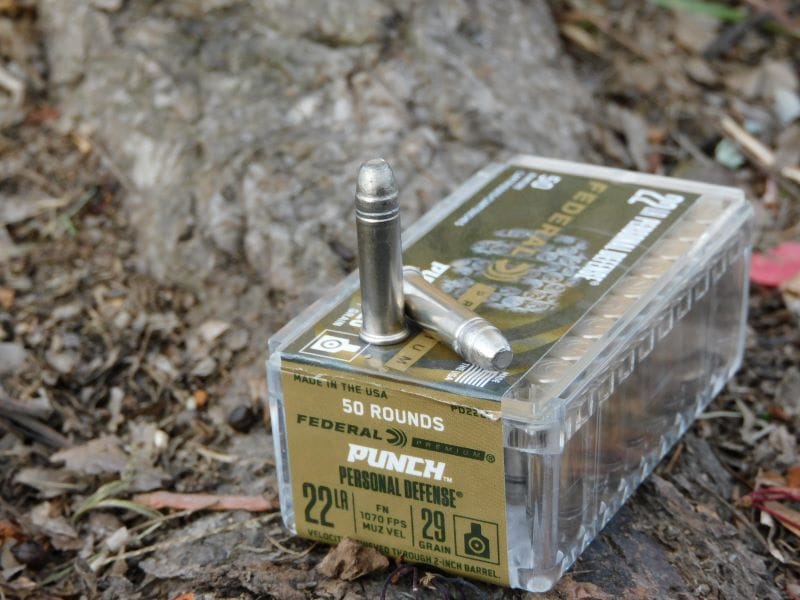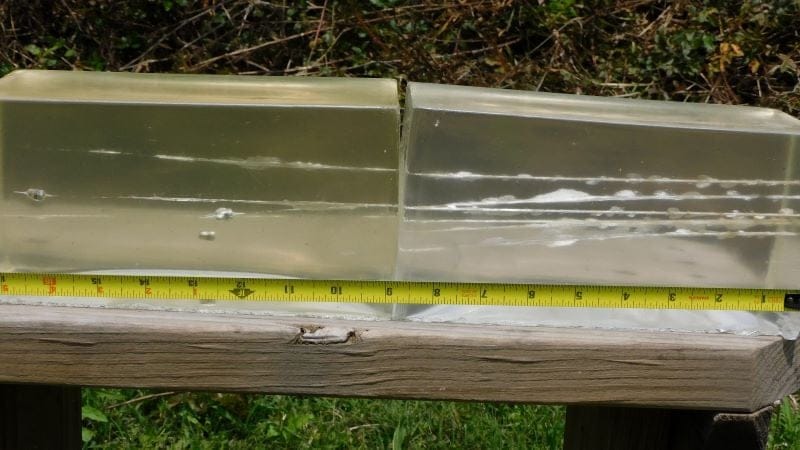The debate over using the lowly 22 Long Rifle cartridge for personal protection and concealed carry has been done to death. With that said, it is a debate I don’t shy away from because there is no clear-cut consensus. For a time, the 22 Winchester Magnum Rimfire cartridge was considered impotent for personal protection. But over the last ten years, ammunition manufacturers like Speer, Federal, and Hornady have debuted dedicated defensive ammunition meant for short-barreled 22 Magnum handguns. Clearly, the round has its fans and the market follows. Its shorter cousin, the 22 Long Rifle, is infinitely more popular and has been for decades. But only in the last few years has some development been dedicated to producing a load designed expressly for self-defense. Enter Federal Punch 22LR.

The Load
The 22 Long Rifle Federal Punch is designed for high velocity and deep penetration when fired out of a short-barreled rimfire handgun. The load uses a 29-grain flat-nosed lead bullet that is plated in nickel. The case is also nickel plated for corrosion resistance. The advertised velocity of 1070 feet per second using a 2-inch barrel. The rounds come packaged in small fifty-round plastic boxes.
When I first heard about the Federal Punch, I was disappointed that a light-for-caliber 29-grain bullet was used instead of a conventional 40-grain projectile that might yield even better penetration at the same velocity. Leaving that aside, the Punch has a lot going for it. Federal dispensed with the idea of a hollow point whose drag would inhibit penetration. Instead, the Punch uses a non-expanding solid bullet. The flat nose also has the benefit of keeping the projectile in a straight path rather than tumbling. Hollow-point drag and tumbling can make the difference between an effective and ineffective hit in calibers this light.
Federal Punch 22LR vs CCI Stinger
One can think of the Federal Punch as a flat-point version of the firm’s CCI Stinger. The Stinger is a 32-grain hollow-point designed for varmint use out of rifles. Out of a short barrel, the Stinger loses quite a bit of its velocity, but as one of the hotter .22 rounds on the market, it is a favorite among those who pack 22 LR handguns for personal defense. To get an idea of where both rounds stand, I shot both over my Caldwell Chronograph from a distance of 10 feet between three guns. The results are as follows:
| Firearm | Federal Punch 29 grain Solid | CCI Stinger 32 grain HP |
| Bond Arms Stinger 3 inch (Two inches of bullet travel) | 1125 | 1108 |
| Ruger Wrangler 3¾ inch | 1233 | 1196 |
| Browning SA-22 19 3/8 inch | 1542 | 1551 |
The Federal Punch 22LR load well exceeded the advertised muzzle velocity using a Bond Arms Stinger. The Bond has a 3-inch barrel, although the ammunition takes up a full inch of chamber. The round had a velocity premium over the CCI Stinger, though arguably marginal, until I shot a string of five rounds out of my Browning SA-22. The difference between them was by a mere nine feet per second. The appreciable difference came in the extreme spread of the rounds, from the lowest to highest velocity in a given string. The spread with the Bond using the Punch load was only 25 feet per second. The Stinger yielded 93 feet per second in deviation.
Out of the Ruger Wrangler’s 3¾ inch barrel, the deviation ranged from 46 to 81 feet per second for the Punch and Stinger respectively. The deviation tightens up to 41 and 88 respectively through the strings fired from the rifle. The Federal Punch might be ballistically similar to the CCI Stinger, but it is a more consistent round. This means those rounds will, theoretically, hit in the same spot.

I ran a quick accuracy test using the Wrangler. From 10 yards, offhand, I shot two six-round strings. Although my shooting was a bit rusty, I was still able to turn in a better group with the Punch over the Stinger.
Federal Punch 22LR Ballistic Gel Test
After confirming velocity and accuracy, I next turned to my standard testing setup: four layers of denim and a few blocks of 10% Clear Ballistics ordnance gelatin. This represents a repeatable worst-case scenario of a heavily clothed attacker in a medium where we can easily compare one round and one cartridge to another. From 10 feet away, I fired six rounds of the Punch from my Bond Arms Stinger and got six easy hits through denim.

I have tested 22 LR ammunition out of rifles and it’s typical to get 12-14 inches of penetration using ordinary solid 40-grain lead ammunition. The same ammunition can generally hit the nine-10 inch mark out of a short-barreled handgun.
The Punch gets very close to rifle velocities out of my little Bond Arms and it did more damage than I expected. I certainly didn’t think a 22-round could clear two of my blocks. But two rounds cleared 17 inches of gelatin and kept going. I captured one round at the 16½ inch mark and two at the 12¾ and 13-inch marks respectively. One round was found between the gelatin blocks and table at fifteen inches. Small-caliber non-expanding bullets tend to tumble, but the Punch’s flat nose seemed to work to keep the rounds on a relatively straight path, ending their journey nose-first. The wound tracts were nothing to write home about, but the penetration was there.

.22LR for Self-Defense?
There are legitimate reasons to pick a 22 for personal defense. Sometimes, the lack of noise and recoil dictates that choice. Sometimes, the need for a small gun outweighs carrying something more capable. And then, sometimes, the 22 is the gun you have on hand. Whatever the reason, ammo selection in these small calibers is paramount. Bulk-pack ammunition tends to have more dud rounds, while smaller packages tend to be more reliable but more expensive. Some rounds like the CCI Copper can be too light to penetrate. Standard high-velocity and hyper-velocity loads can be serviceable, but they lose quite a bit of their speed when fired from small handguns. There are a few excellent 22 LR loads out there, but the Federal Punch 22LR load is the one that punches well above its weight.

